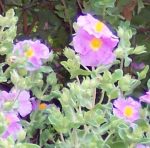 Also known as hoary rock rose and pink rock rose, this evergreen flowering shrub is a member of the Cistaceae family, a small group of shrubs and semi shrubs that do well in dry, sunny locations with poor soil. It is native to Mediterranean areas where it grows in scrub and in bushy places on rocks, dry hills and similar sites. The plants form a mound about 2-4′ tall by 2-3′ wide and have gray-green leaves with wavy edges. From late spring to summer 2″ wide pink or white flowers with 5 crepey petals and a mass of bright yellow stamens appear and attract butterflies and bees. Each flower lasts only a day but the plant has a long bloom time. The stems and leaves of rock rose produces a dark-brown, sticky exude called ladanum, that was historically used in herbal medicine and incense but is now used to make perfume and vermouth. Tolerant of poor soil, drought, salt spray and wind, Cretan rock rose is an excellent choice for a seaside garden as well as a Mediterranean, herb, or rock garden. The genus name, Cistus, is from the ancient Greek word κίσθος (kisthos) meaning basket. The specific epithet, creticus, is from the Greek name for the island of Crete, Κρήτη.
Also known as hoary rock rose and pink rock rose, this evergreen flowering shrub is a member of the Cistaceae family, a small group of shrubs and semi shrubs that do well in dry, sunny locations with poor soil. It is native to Mediterranean areas where it grows in scrub and in bushy places on rocks, dry hills and similar sites. The plants form a mound about 2-4′ tall by 2-3′ wide and have gray-green leaves with wavy edges. From late spring to summer 2″ wide pink or white flowers with 5 crepey petals and a mass of bright yellow stamens appear and attract butterflies and bees. Each flower lasts only a day but the plant has a long bloom time. The stems and leaves of rock rose produces a dark-brown, sticky exude called ladanum, that was historically used in herbal medicine and incense but is now used to make perfume and vermouth. Tolerant of poor soil, drought, salt spray and wind, Cretan rock rose is an excellent choice for a seaside garden as well as a Mediterranean, herb, or rock garden. The genus name, Cistus, is from the ancient Greek word κίσθος (kisthos) meaning basket. The specific epithet, creticus, is from the Greek name for the island of Crete, Κρήτη.
Type: Flowering evergreen shrub
Outstanding Feature: Flowers
Form: Mound
Growth Rate: Rapid
Bloom: Flowers with pink or white crepey petals and bright yellow stamens, from late spring to summer
Size: 2-4′ H x 2-3′ W
Light: Full sun
Soil: Average to lean, medium moist to dry, well-drained; tolerant of drought and salt spray
Hardiness: Zones 9-10
Care: Plant in sheltered area and avoid winter wetness; pinch back and fertilize afer flowering to encourage bushiness; lightly prune to maintain shape; does not tolerate hard pruning or root disturbance.
Pests and Diseases: None of significance
Propagation: Seed, semi-softwood cuttings,
layering in spring
Outstanding Selections:
Not available
Photo Credit: A Barra Wikipedia